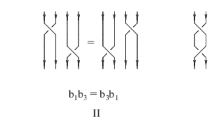Abstract
A procedure to construct positive knots motivated by symbolic dynamics is given. It is proved that the corresponding knots have a special type of positive braids, positive permutation braids. It is proved that the constructed knots are invariant under topological conjugacy, up to period five, hence they can be used to classify discrete dynamical systems. An example is given to show that topological conjugacy failed to be an invariant for closed orbits of period more than five.
Similar content being viewed by others
References
Ahmed, E. and Elrifai, E. A. (2001). Knots motivated by discrete dynamical systems. Chaos, Solitons and Fractals 12(13), 2471–2474.
Ahmed, E., Elrifai, E. A., and Abdellatif (1991). Relation between strings and Ribbon knots. International Journal of Theoretical Physics 30(2).
Birman, J. S. (1974). Braids, links and mapping class groups. Annals of Mathematical Studies 82, Preston University Press, Preston.
Birman, J. S. and Williams, R. F. (1983). Closed periodic orbits in dynamical systems 1: Lorens's equations. Topology 22, 47–82.
Dale, R. (1977). Knots and Links, Publish or Perish.
Elrifai, E. A. (1988). Positive braids and Lorenz links. Ph.D., Liverpool University, Liverpool.
Elrifai, E. A. (1999). Necessary and sufficient condition for Lorenz knots to be closed under satellite construction. Chaos, Solitons and Fractals 10(1), 137–164.
Elrifai, E. A. and Ahmed, E. (1995). Knotted periodic orbits in Rossler's equations. Journal of Mathematical Physics 36(2), 773–777.
Elrifai, E. A. and Benkhalifa, M. (2004). On the conjugation problem of positive braids. Journal of Knot Theory and Its Ramifications 13(3), 311–324.
Ghrist, R. W., Holmes, P. J., and Sullivan, M. C. (1997). Knots and links in three-dimensional flows. Springer Lecture Notes in Mathematics, Vol. 1654, Springer-Verlag, Berlin.
Guckenheimer, J. and Williams, R. (1979). Structural stability of the Lorenz attractor. Publications of Mathematics IHES 50, 101, 307–320.
Hao, B. L. and Zheng, W. H. (1998). Applied symbolic. World Scientific, Singapore.
Holmgren, H. (1996). Introduction to discrete dynamical systems. Springer, Berlin.
Kauffman, L. H. (1996). Knots and applications. Series on knots and everything, Vol. 6, World Scientific, Singapore.
Morton, H. and Hadji, R. J. (2004). Conjugacy for positive permutation braids. Vol. Journal of knot theory and its ramifications.
Author information
Authors and Affiliations
Corresponding author
Rights and permissions
About this article
Cite this article
Elrifai, E.A. Positive Knots From Discrete Dynamical Systems Via Symbolic Dynamics. Int J Theor Phys 44, 1337–1345 (2005). https://doi.org/10.1007/s10773-005-4769-8
Received:
Accepted:
Issue Date:
DOI: https://doi.org/10.1007/s10773-005-4769-8




